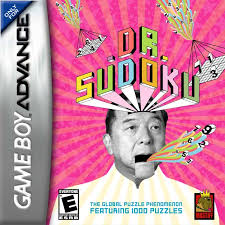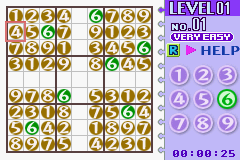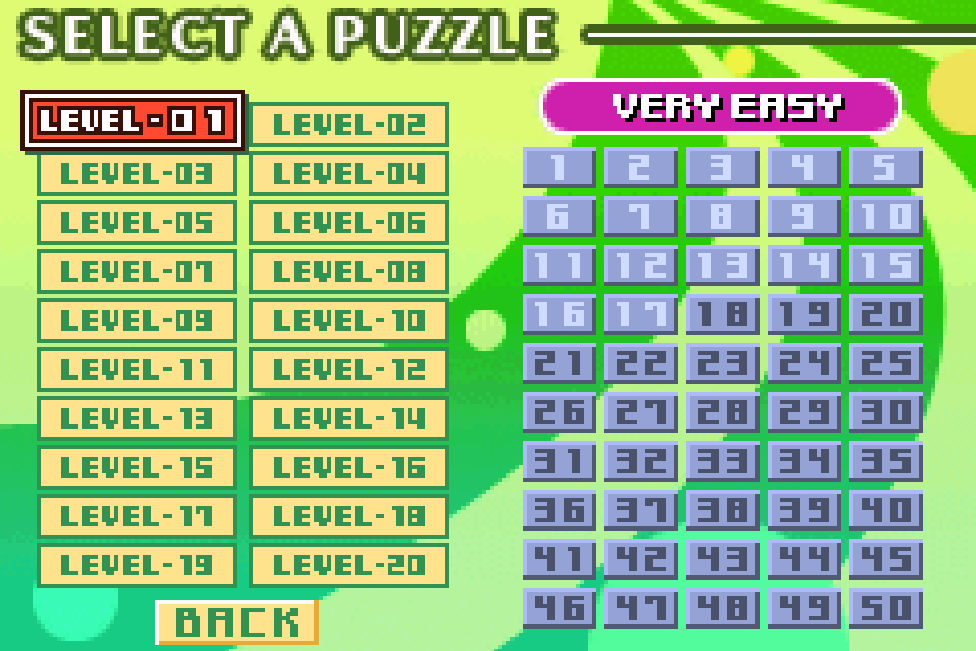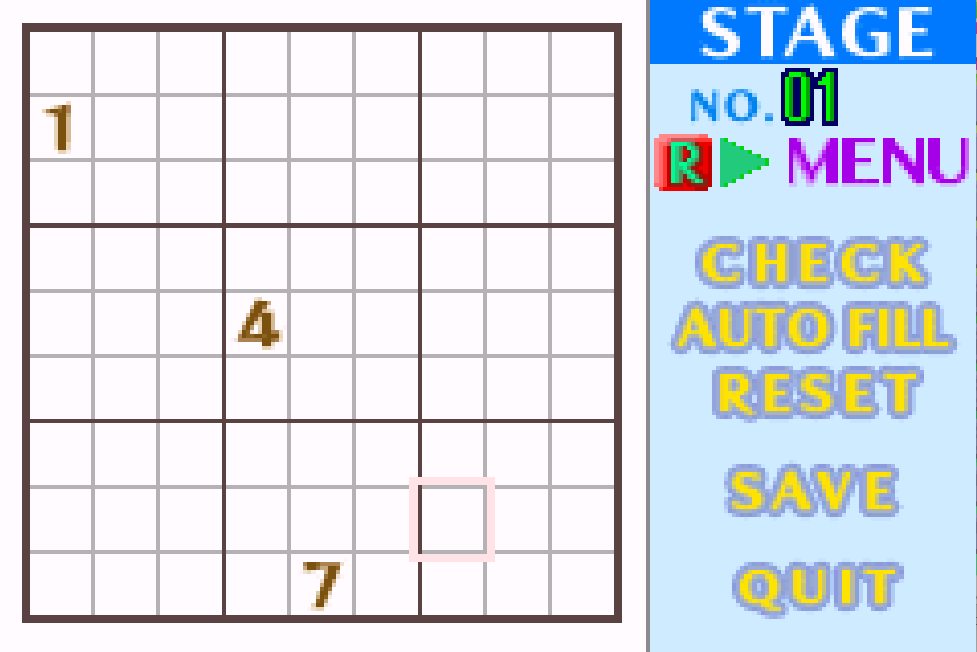Dr. Sudoku - Embaressment of Riches
13/10/25

It wasn’t until the Nintendo DS that I felt the concept of ‘pick up and play’ style games really *worked*. Whilst the Game Boy Advance SP did feature the clamshell design endemic to Nintendo’s handhelds for the next fifteen or so years, the lack of a suspend or sleep mode made longer-term games more feasible to just play at a whim, unless you’re based solidly at home or trapped in the car on a family trip or something. But that didn’t stop a LOT of games coming out in the GBA era still holding onto that ‘pick up and play’ mentality, though this usually came with in the form of shorter levels in platformers, more arcadey, puzzley-styled games in third-parties, and some that… just came out anyway.
Dr. Sudoku, whilst obviously being a puzzler, very much sticks to that last viewpoint; this is a great game, a fantastic way to engage with the endlessly addictive style of 9x9 puzzles. The sheer breadth of, albeit single-minded, content in this game is staggering, but the lack of any features to make it more pick-up and play - namely any kind of sleep mode - makes it a little harder to be an automatic recommendation.
Back To Basics
Dr. Sudoku, aptly enough, is a game about Sudoku. A lot, lot, LOT of Sudoku. For those unaware of how the puzzle of Sudoku is played, you’re given a 9x9 grid, which overall consist of nine 3x3 subgrids. There’ll be a smattering of numbers already filled in, but the crux of the puzzle is simple; you need to fill every blank entry on the 9x9 grid with the numbers 1 through 9, but with each full row and column only containing one of each nine numbers. Secondly, each of the 3x3 subgrids within the larger grid must only contain one of each number of 1 through 9. It’s a pretty simplistic puzzle on the surface, but the sheer, nigh-on limitless amount of combinations gives it a ridiculous amount of longevity.

Early puzzles will ease you into the concept - you’ll have more numbers already filled in, so you won’t have to contend with a ton of investigating to solve your first puzzles. Honestly, beyond one of those ‘Sudoku for Dummies’ books, this really wouldn’t be a bad way to first immerse yourself into this fun style of puzzles. The game also boasts the ability to mark potential numbers for any square, which is incredibly, incredibly useful. This is doubly so for the march harder puzzles where, rather than being able to instantly narrow down which numbers can only go where, you need to slowly narrow down various options until you’re able to find the solution.
All that is to say, Dr. Sudoku is a fairly traditional take on the puzzle of Sudoku. There aren’t any wacky modes or mixups to expect (man, I should look up some of those) so if you simply prefer your sudoku digital to paper, Dr. Sudoku is a good place to start for any puzzler. The game is also fairly forgiving in the sense that there’s no failure state for making too many mistakes. If you try and place a number that exists in the same row, column, or box, the game will prevent you and show you wherever the other number is, pre-placed or not. Handholdy? Maybe. But I don’t mind, personally. I see Dr. Sudoku as a more chill way to engage with sudoku puzzles, if I wanted to go hardcore, I’d go pen and paper, and I’d suggest the same to y’all.
As someone who suffers from heavy tunnel vision during puzzles, not getting screwed over because I didn’t notice that 9 was already in the box I’m repeatedly trying to slam it in like a baby who doesn’t realise the ball does not go in the square hole… Uh, what I’m saying, it’s nice that Dr. Sudoku takes a gentler hand and just tells you that it doesn’t work, nothing more. If this was a ‘three strikes and you’re out’ kind of game, I probably wouldn't have gotten as far as I did in my hours with the title. I like to think I’m not stupid, but I’m quick enough to make dumb mistakes that’d I’d be crashing out on the simplest of puzzles. It’s perhaps not 100% accurate to how you’d play with paper and pencil, but I don’t really mind in the more chill-out form on the Game Boy Advance.
Drowning in Numbers
What makes Dr. Sudoku really stick out amongst not only its contemporaries on the GBA (read: not many), but in Sudoku-style games as a whole is the sheer number of puzzles you have to tackle. Across twenty levels of complexity, there are a grand total of one thousand bespoke puzzles to complete. Sure, there’s probably a bunch of phone apps that boast nigh-on endless amounts of Sudoku puzzles to complete, but I’m willing to bet that the ones in Dr. Sudoku feel… I dunno, a little more hand-crafted? Not to say AI is behind a lot of modern ones, but you know what I mean - I’m sure puzzle creators are a little more willing to put care into a game that’ll be retailing for 39.99 USD then one of those ten dollar Sudoku books.

With literally a thousand puzzles on offer, it’s obviously not surprising that I’ve only scraped the surface of what Dr. Sudoku contains. But I’ve played enough that the game offers an incredible difficulty curve for those not super familiar with this unique brand of brain-teasers. You’ll start with some very simple, easy to parse puzzles, but the complexity increases at a fairly consistent rate - plus, there’s no requirement to complete any puzzles to access later ones. So, if you’re a lot more confident with the puzzles, you can be like me and jump to the third or fourth section to really start grinding away at these brain scratchers.
It also helps that it’s got a smart, no nonsense aesthetic and kickass soundtrack to go along with it! The visuals are very much on the more basic level, with a number of different settable backgrounds and looks for your board, but they all really come down to different coloured accents and backgrounds whilst you’re puzzling away. Could’ve done with a nice starry background or something of the like, but simple is not bad. The soundtrack though - whilst, again, there’s only a handful of different tracks you can set as the background, these are some genuine toe-tappers that really make your Sudoku action feel that much… grand, or tense, or both! The one I had on longest, the first track, unleashed an earworm in me that has been unable to be satiated, but it reminds me of something that I just can’t place my finger on it. In fact, take a break from reading, and listen yourself - maybe you’ll place it!
Wake Me Up Inside
The biggest ‘issue’ that the game has isn’t really it’s own fault, but it’s the platform itself. As I said, it wasn’t until the Nintendo DS that sleep mode became a perpetual feature for Nintendo. The extreme amount of content available in Dr. Sudoku is amazing, but I don’t know if it’s a game that’ll work when you’re out and about. Personally, I’m not consistent at all when it comes to how long it takes me any specific puzzle - sometimes, it’ll only be five minutes, sometimes I’m an idiot and it’ll take me twenty, and with no sleep mode, I can imagine playing this on hardware could be frustrating. I suppose I’m being a little unfair - closing a puzzle does save your progress, but sleep mode was a function in a bunch of random GBA games - it’d be amazing here.
The only real side content to engage with in Dr. Sudoku is the ability to create your very own Sudoku puzzles! I didn’t dive too far into this mode, since I’m more of a solver then a creator in this field, but it seems to be a perfectly functional puzzle creator. Slapping the ‘Solve’ button will tell you if your self-designed puzzle is actually solvable, and if you’re too lazy to fill in the entirety of the squares, you can have the game auto-fill the rest to make a bespoke puzzle. Now, I’m not exactly sure how to build a decent Sudoku puzzle; I don’t understand the basics behind laying out certain numbers in certain spots, or if it’s just about providing the smallest amount of clues, so honestly, the Original Mode allowing you to build your own puzzles isn’t *that* useful or appealing to me, but the fact it exists within this fairly small-scope game doesn’t hurt it at all. Who knows - maybe some of the sudoku puzzle makers of today got their start in Dr. Sudoku! You just never know.

But beyond that, there aren't any real unique ways to engage with sudoku beyond just the literal thousand puzzles to tackle. And that alone is laudable, but I really can’t imagine anyone - myself included - sticking with it *that* long. Sure, maybe playing it on an Android emulator or something might make it all work, but I think what’s more likely is you’ll just burn out long before the complete all one thousand. And that’s not a bad thing inherently! But perhaps some spins on the formula, new ways to uncover ‘clues’ to split up amongst those thousand puzzles might inspire me to spend more time with it then I’ll ever likely do.
Due to the game’s overall singular focus, there really isn’t that ruminate on in this gamey - whilst the lack of a suspend feature on the GBA might hamper Dr. Sudoku’s ability to exist as a pick up and play title, the sheer amount of content on display is incredible. I’ve seen few Sudoku games feature such an excellent difficulty curve and a freeform ability to start where you feel your skillset lay. Plus, if you’re looking at building your own puzzles, it’s not an awful way to pencil down your planned layouts. Did Dr. Sudoku blow me away, in a world where I can find almost endless amounts of puzzles? No. But in the context of puzzles video games from the early 2000s, especially handhelds, Dr. Sudoku really is fantastic, and you could do a lot worse if you want decent Sudoku on the go. There’s probably way better forms to play it in, but hey, it’s me we’re talking about!
This was a nice breather, especially considering how crazy my life has been lately. We’re only a few games away from the big 100, so I hope you’re as excited as I am! As always, you can reach me generally around the internet under GameBoyAbyss and email me at mgeorge7003@hotmail.com or cckaiju@gmail.com. Thanks for reading, and I’ll see you next time!
